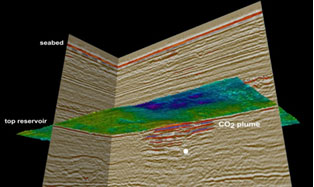Diagnostic Seismic Toolbox for Efficient Control of CO2 Storage: DiSECCS
Carbon capture and storage (CCS) has been identified by the UK Department of Energy and Climate Change (DECC) and the Committee on Climate Change as key to achieving the UK's carbon dioxide (CO2) emissions targets, but two major related issues confront its large-scale rollout: storage integrity and storage capacity. A number of recent papers have highlighted the potential consequences of progressive pressure build-up in storage reservoirs as large amounts of CO2 are injected and highlight important issues concerning pressure increase and geomechanical integrity that have to be faced.
DiSECCS will develop monitoring tools and methodologies to identify and characterise injection-induced pressure build-up in storage reservoirs, to predict the onset of mechanical instability, and to improve in situ quantification and understanding of processes. Seismic techniques provide the key to verifying site performance at the wide spatial scales required (tens of square kilometres and upwards) and our industrial partners, BP and Statoil, have provided unique access to monitoring datasets from the three global large-scale CO2 storage operations: Sleipner, In Salah and Snøhvit.
Experience shows that underground storage of CO2 is associated with significant levels of public concern. A better understanding of these concerns and how they might be manifest is a key element of establishing monitoring protocols to instil wider public confidence in CO2 storage. DiSECCS will draw on analogue activities, in conjunction with a discursive process involving the general public to gain insights into how people engage with similar geological processes and how controversies surrounding particular projects develop and evolve.

